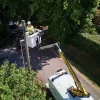6 Months Ahead of Schedule – Suffolk’s Superfast Broadband Rollout
The Suffolk County Council in England has issued a new report on the progress of their £64m project to help extend the coverage of “superfast broadband” (24Mbps+) capable ISP networks to 98% of local premises by the end of 2020, which after some initial delays is now running nearly 6 months ahead of schedule.
The cabinet report notes that the existing £64m state aid supported Better Broadband for Suffolk (BBS) project with Openreach (BT), which is based off the Building Digital UK framework, last month achieved 94.3% coverage of superfast services (up from just 50% in 2013) and that’s a fair bit ahead of where they expected to be at this stage.
According to the report, a recovery plan was developed following a “slippage” of the project, which set new targets for December 2019 and “it is therefore a great achievement to deliver this nearly two quarters ahead of schedule.” Most of the praise for this goes toward Openreach, which is said to have “consistently exceeded the targets set in the recovery plan.”
Advertisement
Overall this means that 348,000 properties containing both residents and businesses across Suffolk UK are now able to benefit from access to faster broadband speeds and better reliability (most of this stems from commercial deployments). Take-up figures of 58.8% have now been achieved across both BBS contract areas (i.e. a total of 84,385 homes and businesses have taken the service).
The take-up figures are important because this will help to activate the clawback (gainshare) clause in related contracts, which requires BT to return some of the public investment as take-up rises. Related funding can then be reinvested in order to further improve coverage.
Report Statement
Whilst these numbers are very positive, we continue to try to improve take-up across the county. Our communications team have recently targeted specific low take-up areas with a leaflet campaign promoting the advantages of superfast speeds and our newly relaunched quarterly newsletter is available on our website.
The procurement phase is underway for the phase 3 contract (aimed at the final 2%). It will prioritise premises with speeds of under 15mbps. It will use a combination of the recently secured DEFRA funding of £1.725m, together with gainshare funding to target some 7000 further premises. The aim is to complete the procurement process by December 2019. We also continue to promote self-dig and community voucher schemes in order to reach the last 2% of premises.
The Suffolk Cloud programme is making good progress to implement a Wide Area Network (WAN) for 311 public sector sites. Sites in Mildenhall are on target to get full fibre by September and work is currently ongoing to prove the fibre routes in the other six smaller towns. Kick-off meetings have been held with all the partner organisations. The programme will require some major civil engineering works in the 10 target towns and the programme team is in discussion with both the Property and Highways departments to ensure this happens as smoothly as possible.
Finally, we are in the early stages of a trial for internet of things (IoT) technology with Norfolk county council following a successful award of £440,000 from the New Anglia Local Enterprise Partnership (LEP). Suffolk is currently scoping the project and the plan will be to implement an LPWAN (Low Power Wide Area Network) which will use sensors to monitor areas such as traffic management and flooding.
We’ve already written an article about the future Phase 3 contract (here), although today’s update appears to clarify that it will aim to reach an additional 7,000 premises and we’d anticipate that most of these will be served by ultrafast Fibre-to-the-Premises (FTTP) lines instead of slower FTTC (i.e. BDUK no longer approves FTTC dominated contracts as that would not be in keeping with the UK Government’s “full fibre” focus).
Openreach seems to be a safe bet to scoop this contract too, although Cityfibre has separately secured the contract to build a new Gigabit (1Gbps+) capable “full fibre” broadband / Ethernet network in Suffolk (here). However, this will initially only focus on connecting public sector sites across 10 towns, before being expanded to reach local businesses (possibly homes too, albeit at a much later date and with more private investment).
Advertisement
All of this should help the county to achieve its “aspiration of reaching 100% Superfast Broadband coverage for Suffolk’s residents and businesses.” We would have liked to include a link to the full report but Suffolk’s java heavy website doesn’t make this easy.
Mark is a professional technology writer, IT consultant and computer engineer from Dorset (England), he also founded ISPreview in 1999 and enjoys analysing the latest telecoms and broadband developments. Find me on X (Twitter), Mastodon, Facebook, BlueSky, Threads.net and Linkedin.
« Virgin Media Completes Another 4000 FTTP Premises in Manchester


















































Comments are closed